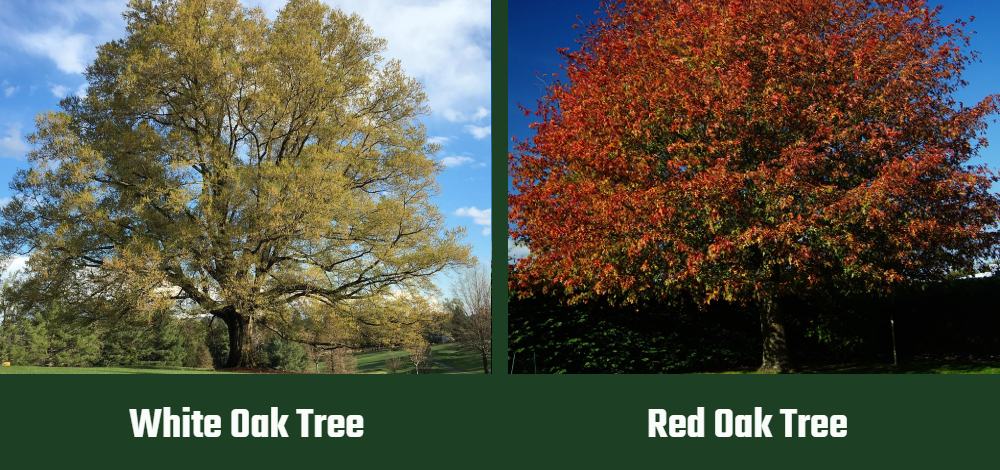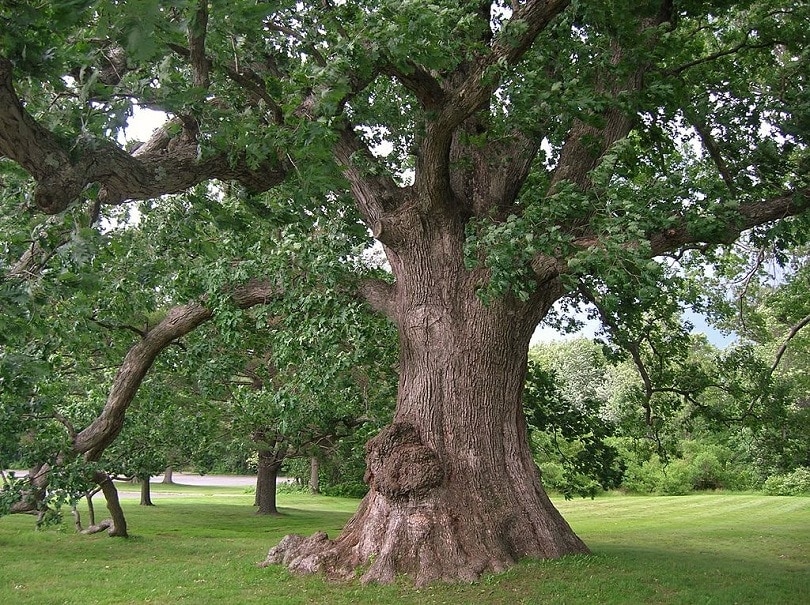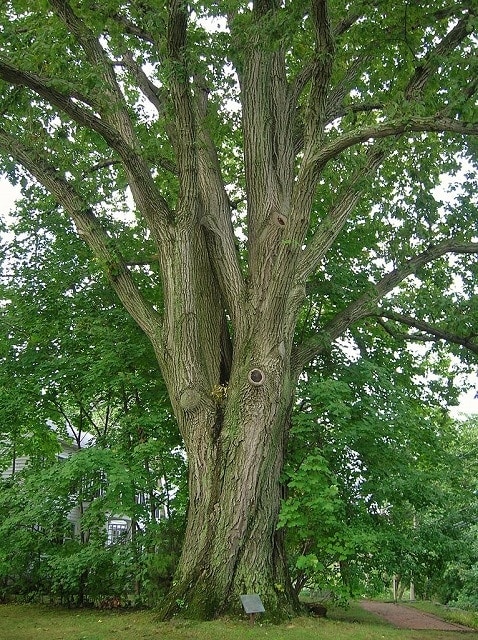White Oak vs Red Oak Tree: What’s the Difference? (with Pictures)
-

- Last updated:


Oak is a popular wood used for many purposes, from furniture making to building barrels for wine and bourbon. The oak tree grows across the United States and Canada, but there’s more than one type of oak. In the United States alone, there are more than 60 native species, and it is a plant that grows around the world.
Luckily, the oak tree can be divided into two families; red oaks and white oaks. What’s the difference between these two oak families? In this article, we’ll explore the main differences between red and white oaks so you can easily tell them apart and understand the differences in how they’re used.
Overview of White Oak Tree

White oak trees are massive, hardy trees that can live for centuries. Their acorns provide food for a wide range of wildlife, while their branches provide shelter and refuge. Good acorn crops only come around once in a while, and it takes 20 years or more for a white oak to start producing acorns at all.
These giants often reach 80 feet and are generally no shorter than 50 feet. Fully mature, they’re just as wide as they are tall, with branches reaching out to form an upward-reaching umbrella that’s 50–80 feet in diameter. Each white oak grows at different speeds. Many grow less than a foot each year, though some can grow nearly 2 feet per year.
Common White Oaks
There are many types of white Oak since it is a family.
- English Oak
- Chestnut Oak
- Bur Oak
- White Oak
- Post Oak
- Chinkapin Oak
Appearance
White oak trees have ashy-colored oak that’s lighter than that of red oak. It’s also very rough. There are deep ridges throughout with triangular cross-sections. You can also tell a white oak by the leaves, which have round edges and no sharp angles. Despite having rough bark, the grain of white oak is very smooth with closed grains.
What’s Special About White Oak?
Beyond their massive size, white oak trees are unique for their wood. Oak looks beautiful as finished furniture or other items, but white oak wood has a particular property that differentiates it from other woods, even red oak.
White oaks have tiny structures in their tissues called tyloses that help the tree survive infection or drought by cutting particular regions of the tree off from the rest. This makes the wood more resistant to water when harvested, which is why white oak is the best wood for making barrels for bourbon and wine.
- Can survive for centuries
- Turns beautiful colors in autumn
- More resistant to rot and drought
- The wood is highly water-resistant
- Grows at a slow to moderate rate
- Difficult to transplant
Overview of Red Oak Tree

Red oaks are large and commanding, though not nearly as impressive in stature as white oaks. The trees don’t spread out as far, and they’re around 45 feet wide. They can reach about 75 feet, though many are as short as 60 feet.
They’re hardy trees and can survive pollution and grow in compacted soil. For the first 10 years of life, a red oak will grow more than 2 feet tall each year. They look beautiful in fall when the leaves turn red and produce acorns that feed just as many woodland critters as white oaks.
Common Red Oaks
Many trees are part of the red oak family. While they all share many similar characteristics, each is its own distinct species.
- Sawtooth Oak
- Scarlet Oak
- Black Oak
- Pin Oak
- Shingle Oak
- Water Oak
- Willow Oak
Appearance
Red oak trees have smooth bark that’s a dark color. There won’t be deep ridges like you’ll find on white oaks, but red oaks have thinner veins running down the sides of the tree. When looking at the grain of bare oak wood, you’ll see many wide pores, unlike white oak.
You’ll also notice that red oak has a distinctly red tint. The leaves of a red oak tree are another dead giveaway. They’re covered in sharp points instead of smooth, rounded corners.
- Related Read: Sequoia Tree vs. Redwood: What’s the Difference? (With Pictures)
- See Also: 8 Different Types of Oak Trees (With Pictures)
What’s Special About Red Oak?
Red oak is a very popular wood for making furniture and other wooden showpieces because of its red tint. It’s a beautiful wood when finished. Plus, since it’s a hardwood, it’s durable and long-lasting and produces the kind of furniture that can be passed down through generations.
- Grows more than two feet per year
- Beautiful colors in the fall
- Grows even with pollution and compacted soil
- Easy to transplant
- Not as water-resistant as white oak
Differences Between Red and White Oaks
Red and white oaks are all part of the same genus but represent different families. Many trees make up the white and red oak families, but the commonalities between the trees of a given family allow us to tell them apart.
Leaves
The leaves offer one of the easiest ways to distinguish red and white oaks since they’re shaped entirely differently. White oak leaves have large, soft, rounded corners with no jagged edges or sharp points. Red oaks are the opposite, with no rounded corners and sharp points everywhere.
Bark
If you know what to look for, the bark of white and red oak trees offers another dead giveaway about what type of oak you’re dealing with. White oaks have rough, jagged bark, but red oaks have much smoother bark that lacks deep ridges.
The Wood
Red oak is easiest to identify by its red tint. Furthermore, it has wide-open pores that you can visibly see since they’re large and numerous. White oak pores close up, so you can’t see many of them. What you can see of white oak pores is very small compared to the large pores in red oaks.
Size
When fully mature, white oaks can be massive, reaching 80 feet tall. Moreover, they’re wide, with branches spreading out approximately the same distance as the tree’s overall height.
Red oaks are pretty sizable and can be nearly as tall as white oaks, but they don’t cover the same amount of space. Generally, red oaks spread to a diameter of around 45 feet, which is only slightly more than half the spread of some giant white oaks.
Growth
Though white oaks can be much larger than red oaks, red oaks are faster growers. On average, red oaks grow more than 2 feet each year for the first 10 years of their lives. White oaks often grow at rates of less than a foot each year, though some can grow much faster.
Conclusion
White oaks and red oaks are two families of oak trees with many similarities. However, it’s the differences that make each special. White oaks are much larger than reds though they grow slower. They have very rough bark, and their wood has closed pores and is water-resistant. The wood of red oaks has a red tint, numerous open pores, and smoother bark than whites. The leaves on red oaks are jagged and pointed, while white oak leaves are smooth with rounded corners.
Featured Image Credit: (L) Candace Freeland from Pixabay | (R) ssmiling from Pixabay
Contents


